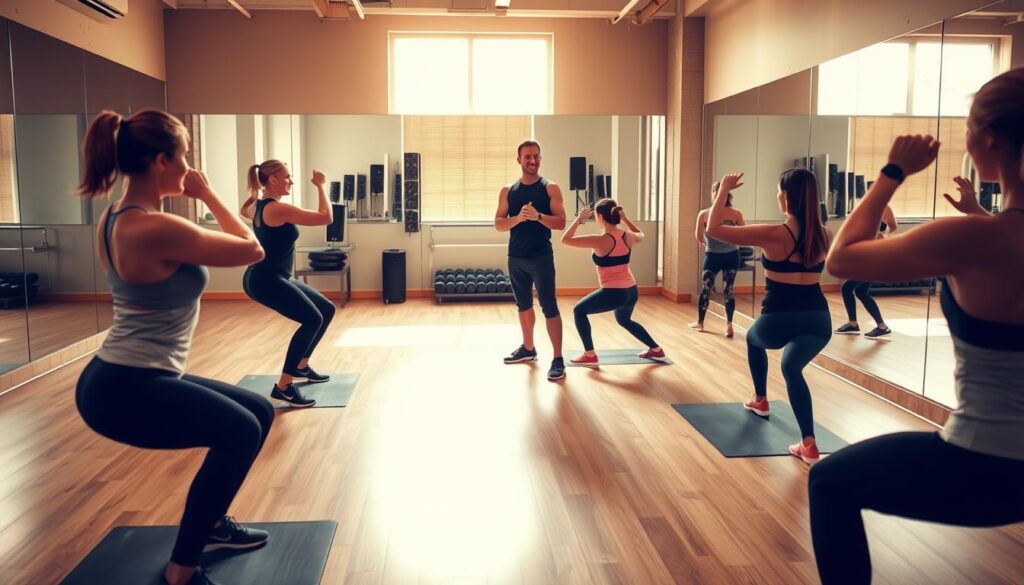Have you ever wondered why some people seem to hit every fitness target effortlessly while others struggle to stay injury free?
Starting a fitness regimen can undoubtedly enhance physical health mitigate the risks of chronic diseases boost self esteem, and improve sleep.
Embracing a structured wellness plan can make the process manageable and efficient, providing a clear path to achieving personal health goals and maintaining a routine that fosters both physical and emotional well-being.
Discover your 5-Step Plan to Stay Fit and Injury Free with these essential fitness tips. Whether you’re a beginner or a seasoned athlete, our well-thought-out approach offers something for everyone.
Key Takeaways
- Learn the importance of measuring your fitness level before starting.
- Discover how to set clear fitness goals and create a balanced routine.
- Understand the significance of gathering the right equipment and using fitness apps.
- Get tips on starting your fitness journey slow and building gradually.
- Emphasize proper techniques and the importance of rest and recovery.
- Learn about the critical role of nutrition and hydration in fitness.
- Stay consistent with your wellness plan to maintain long-term health.
The Importance of Measuring Your Fitness Level
Understanding your current fitness level is essential, as it serves as a benchmark to track progress. By accurately quantifying your physical state you can better tailor a physical fitness program to meet your needs.
Why Knowing Your Baseline Matters
Knowing your baseline fitness level is crucial for setting realistic goals and tracking your progress over time. It helps you understand your starting point and enables you to monitor your improvements as you move through your fitness plan.
The process of measuring fitness progress ensures that you remain motivated and focused on your health objectives.
How to Measure Your Aerobic Fitness
Assessing your aerobic fitness involves measuring how effectively your heart and lungs work during physical activity.
This can be done through pulse rate observations at rest and after exercise. Tracking these metrics helps you determine your cardiovascular health and endurance level. Aerobic fitness is a fundamental component of any comprehensive physical fitness program.
Tracking Your Muscular Fitness and Flexibility
Muscular fitness encompasses both strength and endurance. Simple tests like push ups can help gauge your muscular endurance while specific exercises can measure your flexibility.
Assessing your range of motion is vital for understanding how flexible you are which is an often overlooked aspect of a well rounded fitness plan. Tracking these metrics ensures a balanced approach to physical well-being.
Designing a Comprehensive Fitness Program
Creating a comprehensive fitness program involves setting realistic goals, designing a balanced routine, and incorporating various exercises to avoid monotony and enhance overall fitness.
It is important to tailor the program to your specific needs whether it’s weight loss, muscle gain, or training for a competition. Here’s how you can design a fitness program that suits your lifestyle.

Setting Clear Fitness Goals
Establishing clear fitness goals is the first step to designing an effective workout regimen. Goals provide direction and motivation ensuring you stay on track and measure your progress.
Decide on long-term objectives such as running a marathon or short-term targets like increasing your squat weight. These goals will dictate the specific components of your exercise routine.
Creating a Balanced Routine
A balanced workout regimen includes a mix of aerobic exercises, strength training, and flexibility work. Aerobic activities such as running or cycling improve cardiovascular health while strength training builds muscle and supports metabolism. Don’t forget to include stretching and flexibility exercises to enhance mobility and decrease the risk of injury.
Incorporating Different Activities and Cross-Training
To prevent boredom and overuse injuries, it’s essential to incorporate cross-training into your fitness plan. Cross training involves alternating different types of exercises, such as swimming yoga, and weightlifting to work various muscle groups and systems.
This varied approach not only makes your exercise routine more enjoyable but also optimizes your physical health by promoting muscle recovery and preventing plateaus.
Consider this balanced cross training month’s schedule:
| Day | Activity |
|---|---|
| Monday | Strength Training |
| Tuesday | Yoga |
| Wednesday | CrossFit |
| Thursday | Running |
| Friday | Pilates |
| Saturday | Swimming |
| Sunday | Rest Day |
Gathering the Right Equipment
Achieving a balanced routine and maintaining healthy lifestyle habits begins with gathering the right equipment to support your fitness journey. Selecting the proper gear can make a significant difference in your overall performance and help prevent injuries.
Choosing the Right Athletic Footwear
Selecting the correct athletic footwear is crucial for both comfort and safety. Your choice of shoes should align with the specific exercises you plan to undertake.
For instance running shoes are designed with cushioning and shock absorption, while cross-trainers offer support for a variety of movements. Investing in quality athletic footwear ensures better support and minimizes the risk of injury.
Investing in Practical Exercise Equipment
Practical and engaging exercise equipment can enhance your workout experience. Items such as dumbbells, resistance bands, and medicine balls are excellent options for a home gym.
These pieces of equipment are versatile cost effective and can be incorporated into various workout routines to improve strength and flexibility. Remember the goal is to invest in equipment that you find enjoyable and motivating.
Using Fitness Apps and Tracking Devices
Incorporating technology into your fitness routine can significantly aid in monitoring progress and staying motivated. Fitness apps and tracking devices provide valuable data on performance, helping you set and achieve specific fitness goals.
Whether it’s tracking your steps monitoring heart rate or logging workouts these tools can tailor training programs to fit your personal needs. Embracing these technological advancements supports your healthy lifestyle habits and keeps you on track with your fitness journey.
Starting Your Fitness Journey
Beginning a fitness journey is an exciting step towards improving your overall health and well-being. It’s essential to incorporate warm-up exercises, start gradually, and build a diverse routine to stay motivated and engaged.

Warming Up Properly
Warming up properly before diving into strenuous activities is critical to prevent injuries and enhance performance. Warm up exercises prepare your body by increasing blood flow to muscles and raising your heart rate.
Common warm-up activities include dynamic stretches, light jogging and movement drills. This not only readies your body but also sets the tone for a productive workout.
Starting Slow and Building Gradually
When starting a fitness journey it’s crucial to begin slowly and increase intensity over time. This method helps in building endurance and reduces the risk of injuries.
Begin with low-impact exercises and gradually incorporate more challenging workouts. Monitoring progress and making incremental improvements can boost confidence and lead to long-term success.
Creativity in Exercise Routine
To maintain enthusiasm and consistency, it’s beneficial to add creativity to your exercise routines. Vary your workouts by mixing different types of activities such as swimming, cycling, weight lifting, and yoga. This approach not only helps in building exercise routine© but also targets different muscle groups, preventing boredom and promoting overall fitness.
Physical fitness is not only one of the most important keys to a healthy body; it is the basis of dynamic and creative intellectual activity. John F. Kennedy
Maintaining variety and creativity in your exercise routine can keep you motivated and committed to your fitness journey, leading to sustained physical and mental health benefits.
- Dynamic Stretches
- Light Jogging
- Swimming
- Cycling
- Weight Lifting
- Yoga
By integrating these tips into your fitness strategy, you can confidently embark on a new path to health and vitality.
Checking Your Progress Regularly
Maintaining a consistent check on your fitness regimen is essential for achieving your goals and staying motivated. By regularly monitoring your progress, you can ensure that your efforts are leading to tangible results.
Assessing Your Fitness at Regular Intervals
Consistently assessing your fitness level allows you to track your improvements and identify areas that need more attention. This monitoring can be done through various methods such as performance tests, fitness tracking apps, or periodic health check-ups.
Key indicators like endurance, strength, and flexibility should be part of the assessment routine.
Setting New Goals and Staying Motivated
Once you’ve gauged your current fitness level it’s important to set new, attainable goals to keep your motivation high. Your goals should evolve as your fitness improves.
Tracking fitness progress setting fitness goals, and maintaining fitness motivation are vital components of a successful fitness plan. Regularly updating your goals keeps you engaged and continually challenged, ensuring sustained progress over time.
Using Proper Technique to Avoid Injuries
Maintaining proper exercise techniques is essential for injury prevention and achieving your fitness goals. Understanding and practicing correct form during exercise not only enhances effectiveness but also protects against potential injuries.
Learning Correct Exercise Form
Whether you’re lifting weights, running, or engaging in yoga, each activity has specific movements and postures that need to be followed meticulously.
Proper exercise techniques ensure that your body is moving in the safest and most efficient manner. It’s always beneficial to start with foundational exercises such as squats, lunges, and push-ups, focusing on alignment and control.
Consulting Trainers for Professional Guidance
Seeking professional training advice can dramatically improve your workout routine. Experienced trainers can provide personalized guidance tailored to your individual capabilities and goals highlighting areas for improvement and suggesting adjustments to your techniques.
Regular consultations with professionals can lead to significant progress in both fitness and injury prevention.
Having access to expert opinions is especially crucial when beginning a new type of exercise or sport. The structured feedback and customized program adjustments ensure that you continue to advance safely and effectively.

| Benefits of Proper Technique | Examples of Common Mistakes |
|---|---|
| Enhanced performance and results | Incorrect posture in weight lifting |
| Reduced risk of injuries | Improper running gait |
| Greater efficiency in movements | Skipping warm-up exercises |
Importance of Rest and Recovery
Balancing intense workouts with adequate rest and recovery is essential for overall fitness. Resting helps prevent overtraining and promotes muscle repair, leading to more sustained progress.
Scheduling Rest Days
Incorporate regular rest days into your fitness plan. It allows muscles to heal thereby improving your performance in subsequent workouts. Rest days are not just about doing nothing they are crucial for muscle growth and recharging your body.
Using Active Recovery Techniques
Active recovery such as light cardio or yoga, can speed up the recovery process. These techniques keep the blood flowing, reducing muscle stiffness and soreness. Adding active recovery sessions can enhance your overall fitness and reduce the risk of injuries.
Listening to Your Body
Pay attention to signs of fatigue or discomfort. Listening to your body helps you understand when to push and when to rest. By honoring your body’s signals, you can avoid overtraining and facilitate better recovery.
Nutrition and Hydration Tips for Fitness
Maintaining a nutritious diet and proper hydration are essential components for anyone invested in fitness. A strategic approach to nutrition aids in muscle recovery, while consistent hydration enhances overall performance.
Balanced Diet for Muscle Recovery
A balanced diet is fundamental for muscle recovery. Consuming a mix of macronutrients proteins carbs, and fats ensures that your body has the necessary resources to repair and build muscle tissues. Include lean proteins from sources such as chicken fish, and tofu.
Carbohydrates from whole grains fruits, and vegetables provide sustained energy while healthy fats from avocados nuts, and olive oil support overall health.
Staying Hydrated During Workouts
Hydration is crucial for optimal performance during your workouts. Drink plenty of water throughout the day, not just during physical activity.
Carry a water bottle with you and take regular sips before, during, and after workouts to prevent dehydration. Consider incorporating electrolyte-rich beverages if you’re engaging in extended or particularly intense exercise sessions, as they help replenish minerals lost through sweat.

Posture and Its Impact on Fitness
It’s no secret that posture and fitness are deeply interconnected. Proper posture can enhance your workout effectiveness and help avoid injuries. Integrating posture awareness into daily routines and exercises can make a significant difference in overall well-being.
Maintaining Proper Alignment at Work
Maintaining alignment throughout the day begins with how you position yourself while working. Whether you’re at a desk or on the go, being mindful of your posture can reduce strain on your muscles and joints. Invest in ergonomic furniture and take frequent breaks to stretch, promoting better posture and fitness habits.
Correct Form During Exercise
Exercise form is critical when it comes to maintaining alignment. Incorrect technique can lead to injuries and less efficient workouts. Always prioritize form over speed or weight ensuring you are engaging the right muscle groups. This focus not only improves performance but reinforces good posture, contributing to overall posture and fitness.
Staying Consistent with a Fitness Plan
Achieving long-term fitness requires more than just enthusiasm; it demands consistency in fitness. Developing commitments to regular exercise routines can be challenging, but it is crucial for sustaining progress and reaching your health goals.
To facilitate consistency in fitness, it is important to embed exercising habits into your daily life. One effective approach is setting specific, achievable goals that keep you motivated. This ensures that maintaining a exercise routine becomes second nature, not just an option.
Furthermore, diversifying your exercise routine helps in preventing boredom and maintaining engagement. Whether it’s alternating between cardio and strength training or incorporating activities like yoga and pilates, a varied schedule enhances your long-term fitness journey.
Regular self-assessment plays a vital role in staying consistent with a fitness plan. Tracking your progress over time enables you to recognize improvements and recalibrate your routine if necessary. This approach not only bolsters motivation but also secures a pathway to achieving sustained fitness goals.
Conclusion
Achieving fitness goals requires dedication, consistency, and a well-structured plan. Throughout this guide, we’ve explored various steps to embark on a successful fitness journey.
From measuring your fitness level and designing a comprehensive fitness program to gathering the right equipment and starting your fitness journey on the right foot, every aspect has a pivotal role in the broader scope of health and wellness achievements.
The benefits of a fit lifestyle extend beyond physical appearance; it significantly enhances overall wellness and quality of life. Proper technique, rest, and recovery are crucial to avoid injuries and promote long term health.
Additionally, maintaining proper hydration and nutrition can significantly impact your results, driving you closer to your fitness goals.
Remember, consistency is key in staying fit and injury free. Regular progress checks keep you motivated and help in setting new, achievable milestones.
With the right approach, tools, and mindset anyone can embrace a fit lifestyle and enjoy the long-lasting benefits and wellness achievements it brings. Commit to your fitness journey today and witness the transformative impact it can have on your health.





